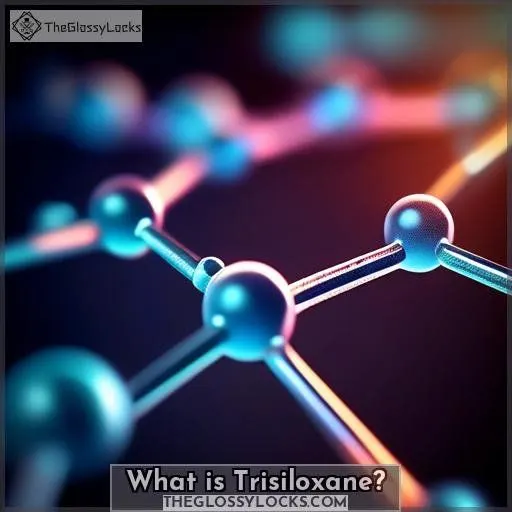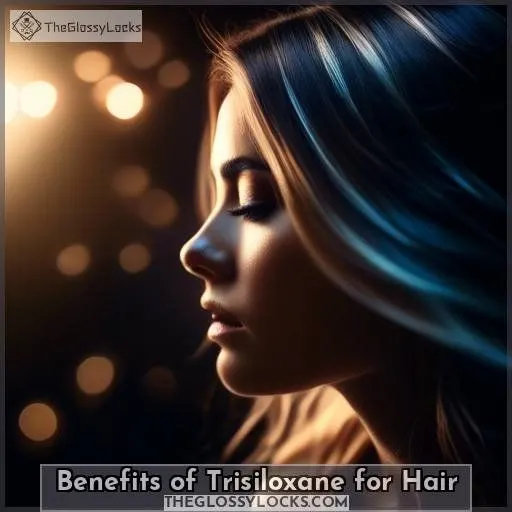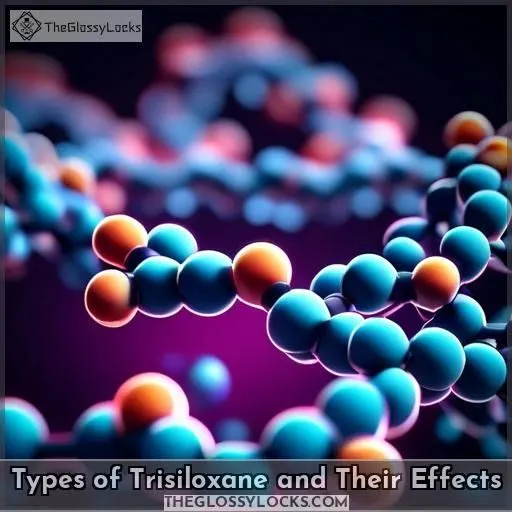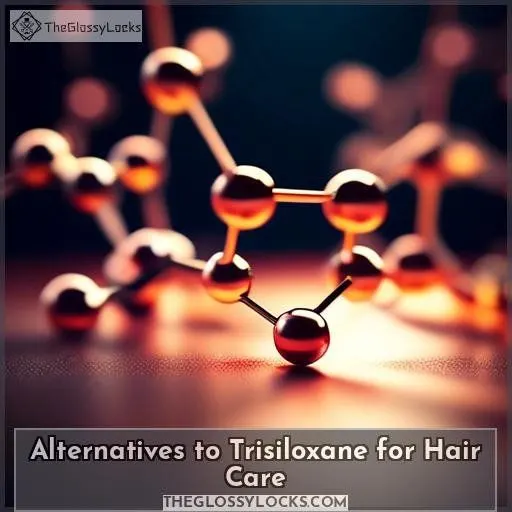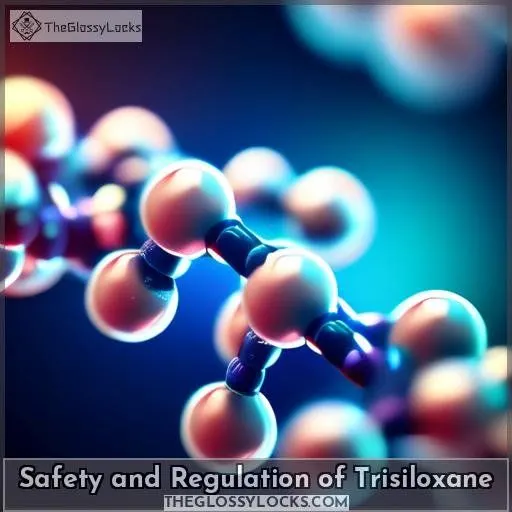This site is supported by our readers. We may earn a commission, at no cost to you, if you purchase through links.
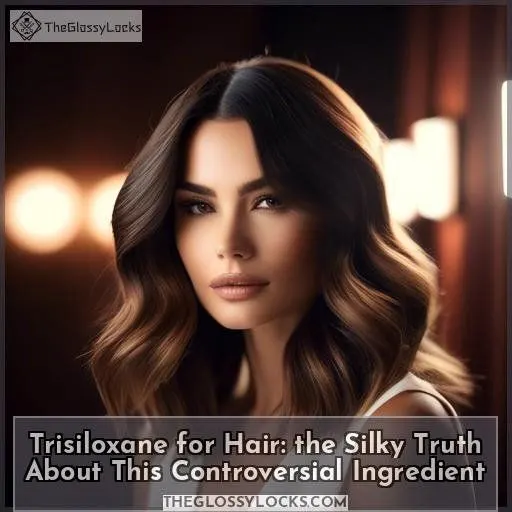
Trisiloxane is the silky silicone ingredient that gives your hair products that coveted smoothness and shine. However, you’ve heard concerns – trisiloxane can create moisture-blocking barriers, potentially drying out and damaging curly hair over time.
While it offers heat protection and prevents damage, buildup is an issue. Different types like water-soluble and volatile silicones provide smoothness without the downsides.
Still, toxicity and environmental impact are valid concerns you’ll want to explore further. Unraveling trisiloxane’s nuances reveals when and how to safely incorporate it into your hair care routine.
Table Of Contents
Key Takeaways
- Trisiloxane is a silicone ingredient found in hair care products that provides a silky texture, slip, and shine to hair.
- It has raised concerns due to its reputation as water-repellent and potentially drying, as well as its moderate persistence and bioaccumulation.
- Different types of trisiloxane, such as water-soluble and volatile silicones, offer alternatives with fewer downsides.
- Safety and toxicity concerns, including regulatory adherence and long-term health effects, should be considered when using trisiloxane in hair care products.
What is Trisiloxane?
Trisiloxane, also known as octamethyltrisiloxane, is a silicone ingredient commonly found in hair care products.
It’s a type of trisiloxane, a family of ingredients that provide a silky texture, slip, or shine to hair.
Despite its widespread use, trisiloxane has raised concerns in the curly community due to its reputation as water-repellent and potentially drying.
It has also been flagged for its moderate persistence and bioaccumulation, and moderate non-reproductive organ system toxicity.
However, it’s worth bearing in mind that trisiloxane has a low ecotoxicology score.
As with all cosmetic ingredients, it’s important to take into account the safety profile and potential alternatives when making a choice about hair care products.
Benefits of Trisiloxane for Hair
You’ve likely encountered trisiloxane in many hair care products, as it’s a silicone that imparts silkiness, slip, and shine to strands. But trisiloxane also carries some baggage in terms of potentially disrupting curl patterns and causing buildup over time. So let’s explore the benefits and drawbacks of using this multitalented yet controversial ingredient for keeping your hair healthy and beautiful.
Silicone Benefits
Trisiloxane, a type of silicone, is a popular ingredient in hair care products due to its unique benefits.
It provides a silky texture, slip, and shine to hair, making it an industry staple.
However, some concerns arise regarding its potential to form moisture-blocking barriers and its impact on curly hair hydration.
Despite these concerns, Trisiloxane is widely used in hair care products due to its versatility and the difficulty of achieving similar results with alternative ingredients.
It’s also used for hair conditioning, UV protection, heat styling, and to prevent hair damage.
Some alternatives to Trisiloxane include oils, waxes, or mineral oil, but these can also form barriers and cause build-up.
It’s essential to evaluate the solubility and removability of ingredients when choosing hair care products.
Curly Hair Hydration
Trisiloxane, an ingredient found in hair care products, is renowned for its ability to impart a silky texture, glide, and sheen to hair.
However, its application in curly hair, which is dependent on moisture retention, can be contested. Obstructive silicones, like trisiloxane, can create moisture-blocking barriers, potentially resulting in accumulation and dehydration of curly hair.
Water-soluble silicones and volatile silicones are viable options, but they may not confer the same advantages.
Ingredient transparency is indispensable when selecting hair care products, as certain silicones may have usage limitations or raise safety and toxicity concerns.
Safety and Toxicity Concerns
Trisiloxane, also known as octamethyltrisiloxane, is a common ingredient in hair care products, providing a silky texture, slip, and shine. However, it has moderate concerns for persistence, bioaccumulation, and non-reproductive organ system toxicity, with limited data availability. Regulatory adherence is vital, as products containing this ingredient may be restricted, and long-term health effects aren’t fully understood.
Types of Trisiloxane and Their Effects
Trisiloxane comes in various forms, each with its own effects on hair. Here’s a quick rundown of the main types:
- Occlusive Silicones: These are water-repellent and form barriers, which can be beneficial for some hair types. However, they require cleansing to remove, and overuse can lead to buildup and potential moisture-blocking effects.
- Water Soluble Silicones: These are easily emulsified and wash away with water, making them a good choice for those who want to avoid residue buildup.
- Volatile Silicones: These evaporate during drying and don’t leave a residue, making them a popular choice for those who want a lightweight, non-greasy feel.
- Trisiloxane for Skin Conditioning: Trisiloxane is also used in skin care products to provide a silky texture and slip, making it a versatile ingredient across industries.
When considering trisiloxane for hair care, it’s crucial to be aware of its solubility, removability, and potential for hair buildup. For example, occlusive silicones can create a water-repellent barrier, which may not be suitable for curly hair that needs hydration. Water-soluble and volatile silicones offer different benefits and may be more appropriate for specific hair types or preferences.
Alternatives to Trisiloxane for Hair Care
If you’re seeking alternatives to trisiloxane for your hair care routine, here are four options to mull over:
- Water-Soluble Silicones: These silicones are readily emulsified and rinsed away with water, making them a wise choice for those concerned about accumulation.
- Volatile Silicones: These silicones vaporize during drying, leaving no residue behind. They’re a sensible choice for those who favor products that aren’t heavy.
- Oils, Waxes, or Mineral Oil: Some individuals opt for natural alternatives like oils, waxes, or mineral oil to attain the smoothness, shine, or texture that trisiloxane provides.
- Other Silicones: There are innumerable types of silicones utilized across industries, so if you’re not concerned about trisiloxane specifically, you may find other silicones that perform better for your hair type or preferences.
Safety and Regulation of Trisiloxane
Regarding trisiloxane, it’s understandable to question its potential to harm your hair.
Consider this: OECD testing is comparable to an investigator, meticulously examining every aspect for evidence of skin absorption and bioaccumulation.
Although it provides a silky texture, is it a deceptive ingredient?
Ecotoxicity evaluations thoroughly investigate environmental effects, while ingredient regulations serve as gatekeepers, permitting only safe substances.
Therefore, before applying the product, bear in mind that appearances can be deceiving.
Conclusion
As you navigate the silky world of trisiloxane for hair, remember that knowledge is power. Weigh the benefits against the potential drawbacks, explore alternatives, and make informed choices custom-designed to your unique tresses. By staying curious and vigilant, you can harness the power of this controversial ingredient while prioritizing the health and radiance of your crowning glory.

